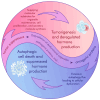Targeting Autophagy for Pituitary Tumors
- PMID: 40361329
- PMCID: PMC12070981
- DOI: 10.3390/cancers17091402
Targeting Autophagy for Pituitary Tumors
Abstract
Pituitary tumors, arising from the pituitary gland, can be classified as functioning or non-functioning based on their hormone production. Previous studies demonstrated that impairment of cellular processes, such as autophagy, a crucial cellular recycling mechanism, has been implicated in pituitary tumorigenesis and hormone dysregulation. This review comprehensively examines the intricate relationship between autophagy and pituitary tumors. We explore the multifaceted role of autophagy in cancer, highlighting its dual nature as both a tumor suppressor and a promoter depending on the context. We also discuss the specific mechanisms of autophagy, including macroautophagy, mitophagy, crinophagy, and their relevance to pituitary tumorigenesis and hormone regulation. Furthermore, we analyze the current literature regarding the impact of various therapeutic interventions in pituitary tumor cells, with both autophagy-promoting and autophagy-inhibiting strategies. We address the challenges in interpreting autophagy activity and its complex interplay with hormone production. Current evidence suggests the potential of targeting autophagy as a therapeutic approach for pituitary tumors, emphasizing further research and clinical trials to determine the optimal strategy for individual patients and improve long-term outcomes.
Keywords: autophagy; cell proliferation; hormone production; pituitary tumors.
Conflict of interest statement
The authors declare no conflicts of interest.
Figures

References
Publication types
LinkOut - more resources
Full Text Sources

